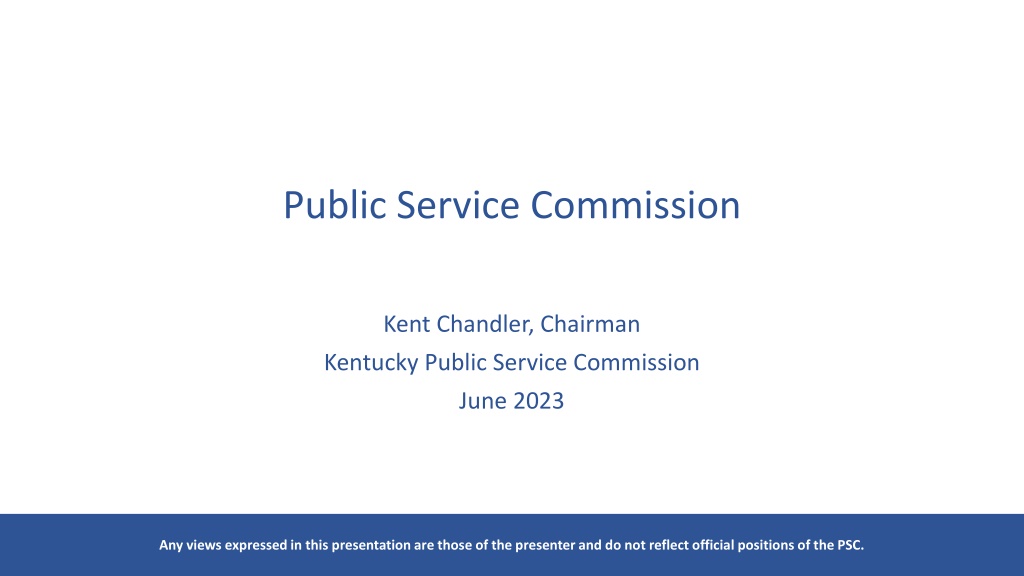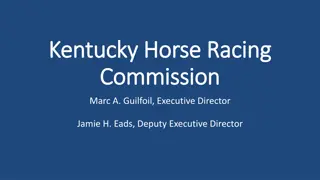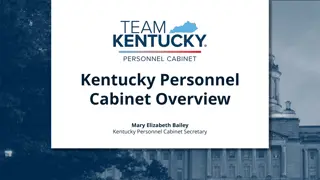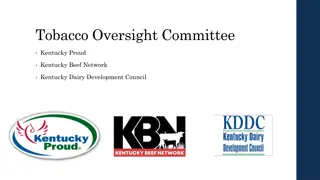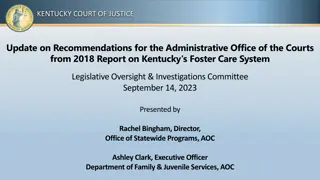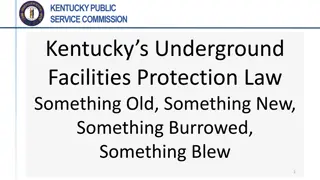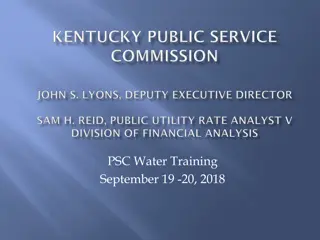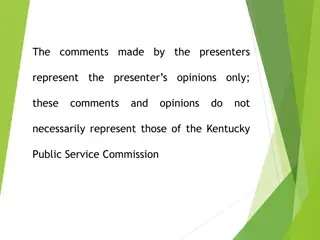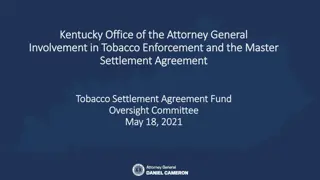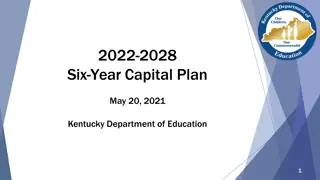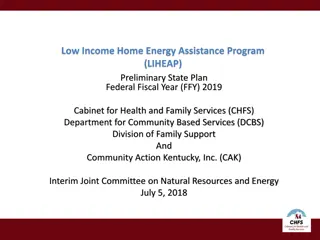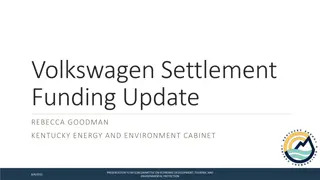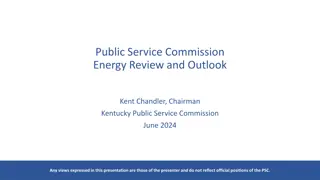Insights into Kentucky Public Service Commission Functions and Challenges
The presentation sheds light on the roles of the Kentucky Public Service Commission (PSC), emphasizing its regulatory functions over various utilities such as water, natural gas, electricity, and more. It discusses the key principles of utility regulation in Kentucky since 1934, focusing on rates and service quality. Furthermore, it highlights internal challenges faced by the PSC, including turnover rates, staffing issues, and the need to enhance technical skills among personnel. Lastly, it delves into the investigation of the Fuel Adjustment Clause and its impact on utilities and customers.
Download Presentation

Please find below an Image/Link to download the presentation.
The content on the website is provided AS IS for your information and personal use only. It may not be sold, licensed, or shared on other websites without obtaining consent from the author. Download presentation by click this link. If you encounter any issues during the download, it is possible that the publisher has removed the file from their server.
E N D
Presentation Transcript
Public Service Commission Kent Chandler, Chairman Kentucky Public Service Commission June 2023 Any views expressed in this presentation are those of the presenter and do not reflect official positions of the PSC.
Public Service Commission Independent Regulatory Agency Three-member Commission Two new Commissioners in past year Quasi-judicial function Regulates rates and service provided by jurisdictional utilities: 1,100 jurisdictional utilities Water and sewer utilities (small systems comprise the bulk of regulated utilities) Natural gas distribution systems and intrastate pipelines Electric utilities (investor-owned and jurisdictional cooperatives) Telecommunications (small number) Does not regulate municipal utilities except for gas pipeline safety. Does not regulate cooperatives served by TVA. 2
Service and Rates Since 1934, the primary statutory directive of utility regulation in Kentucky revolves around: Rates Fair, just and reasonable Service Adequate, efficient and reasonable Most everything in retail utility regulation comes back to one or both of these principles. 3
Inside the PSC Turnover on Commission since 2021 Staffing PSC has half the employees it had 20 years ago Entered 35% more orders in 2022 than 2018 Complete turnover in entire financial division s management over past year Annual turnover for attorneys is between 20-35% annually the past few years Trying to work smarter and harder Internal reviews of processes Using technology 4
Other Personnel Need more employees, and employees with experience or time to train Need to reduce turnover Need more emphasis on technical skills, wholesale issues, and smallest utilities Wholesale issues- 2 RTOs, SERTP, FERC Gas and Electric, The above doesn t include national issues, like congress, and federal agencies 5
Investigation of the Fuel Adjustment Clause The FAC regulation has been in effect for 40 years, was in tariffs before that. Time to kick the tires Senate Resolution The FAC regulation allows jurisdictional utilities to reflect, through a line item on customers bills, the incremental or decremental cost of purchased power and/or fuel. Expenses incurred in a particular month appear in a subsequent month. Fuel costs make up a significant portion of the cost of providing electricity. For instance, in 2021, Kentucky Utilities, the largest utility in the Commonwealth, had approximately $1.64B in retail sales, while of that, $500M, or almost 1/3 of sales, was a pass through of fuel costs. As we ve seen in the last year, fuel expenses can fluctuate widely. Compared to the past 10 years, all electric and natural gas utilities have experienced higher fuel and purchased power costs in recent months (12-18). 6
FAC Investigation, continued Commission asked a number of questions, including: What changes to the FAC regulation, if any, could reduce the monthly volatility of the FAC? What changes to the FAC regulations, if any, could reduce exposure of the FAC to volatility in the wholesale power market? How does the current structure of the FAC regulation affect the efficiency and reliability of power plants, if at all? Commenters suggested a number of amendments, including cost sharing, levelizing charges, and stricter review of purchases. Case is open and pending. Changes would be prospective. 7
Regulating Incentives Utilities in Kentucky are not competitive businesses, but instead have their rates and service regulated by the PSC Historically, there was a concern around the duplication of the same service, leading to the inefficient investment of capital Electric Utilities, for instance, were provided defined service territories: They have an obligation to serve everyone who demands service in that territory A state granted monopoly creates two primary problems: risk of poor service, and monopoly profits in excess of costs Solution: regulate the utility s rates and service 8
Regulating incentives, continued The rate regulation of monopoly utilities is a function of costs Since society has concerns about the prices a monopoly would charge, including IOUs charging rates in excess of costs or publicly-owned utilities charging rates below costs, rates are created based on the costs incurred or expected to be incurred by a utility However, different entities have different incentives For profit (Shareholder owned) v. Not for profit (Customer Owned) For profit entities have a profit motive Customer-owned entities may have a motive to keeps costs low (too low), which can degrade service Water Districts- depreciation Distribution Cooperatives- Vegetation Management 9
Regulating incentives, continued In acknowledgement that different entity and governance structures have different incentives, the Commission has attempted to create processes to positively address those distinctions Water Districts Following investigation (Case No. 2019-00041), the PSC placed a greater emphasis on ensuring rural water districts have revenues sufficient to address aging systems, water loss and other problems that degrade service. Began instituting defined, transparent surcharges to address water loss R.E.C.C.s- Created pilot streamline process to incentivize periodic, incremental rate increases Majority of costs originate with G&T or at wholesale level Limited number of cost drivers- Depreciation, wages, vegetation management, etc. Intended to increase frequency of rate increases, while reducing size of increases, in recognition that the utility doesn t have an incentive to increase the expenses Cutting largest costs likely to drive down reliability, and further drive costs 10
Regulating Incentives, continued This only makes sense. These utilities are not investor-owned Investor-owned utilities make more profit the more they invest This is assuming the cost of equity capital is constant The PSC determines the cost of equity capital in rate cases, to ensure that the utility shareholders rate of return on their equity investments are commiserate with the risk experienced by the investment Since IOUs earn a return on investment, if investments go up, so do profits. Its this incentive to increase certain costs, namely capital costs, between rate changes, that is one of the primary differences between IOUs and RECCs 11
Looking Forward- Changes to regulations General Regulations Looked to change in 2020- Delayed due to resources RECC Streamline Process- Explained above Fairly successful process Certainty with regulation should reduce costs and resources for utilities and PSC alike Integrated Resource Plan Discussed publicly in the last year Same with general regulations, put on pause due to lack of resources Needed to address energy adequacy and affordability going forward 12
Integrated Resource Planning Integrated Resource Planning (807 KAR 5:058) prescribes rules for regular reporting and commission review of load forecasts and resource plans of electric utilities to meet future demand with an adequate, reliable supply of power within their service areas. Filed every three years 15-year planning horizon includes historical and projected usage, resource, and financial data, and other operating performance and system information. IRPs include summary of planned resource acquisitions, new power plants, transmission improvements, etc. Plans are reflective of expected data- fuel, environmental and operational costs play a huge role in resource choices to serve load 13
2023 Legislative Session Senate Bill 4 Related to the retirement of fossil fuel-fired generators Already in effect PSC processing first case under the law Senate Bill 192 Related to Securitization Goes into effect this year House Bill 4 Related to Merchant Solar Goes into effect this year 14
Securitization Is the process of financing cash flows from a specific asset or pool of assets, and issuing claims on these assets, through the issuance of asset-backed securities. More simply, securitization is a process set out by a state statute that can permit customers of a utility to effectively buy an asset from a utility using money provided by bonds financed by lenders. Effectively, since the utility earns an equity and debt return on their own investments, replacing that investment with only debt capital reduces the financing costs of that asset. The bonds used to buy out the utility are sometimes referred to as ratepayer-backed bonds because they are financed on the premise that a utility s customers, pursuant to a statute, have guaranteed the repayment of the bond according to predetermined schedules. 15
Securitization- Why? Some costs are nonrecurring, one-time, extreme, or are otherwise not ordinary property that makes utility financing of those costs expensive for customers and unnecessarily burdensome for a utility Debt costs less than equity capital Although the principal amount is the same, the reduction in the interest rate, coupled with the time value of money, can lead to significant customer savings compared to the status quo Utilities make investments in assets for the public benefit; they are not financing entities. Having them hold investments and receive a return on paper assets may not be the best use of their limited capital Securitization allows the utility to get out of investing in a paper asset, and put that capital to use, likely to invest in the assets to replace whatever the regulatory asset is related to (like the replacement generator in the scenario) Reduce the costs to customers of decisions or outcomes beyond most any stakeholder s control 16
Securitization Facts About half of states have legislation on the books allowing securitization Some are more prescriptive than others Some permit different types of bond marketing (utility v. state bonding authority) Different states allow securitization to apply to certain types of assets or costs, while some have complicated criteria that have to be met in an application: Retired generation Extreme fuel costs (winter storm Uri) Wildfire costs Extreme storm damage, such as hurricanes Debt is not backed by full faith and credit of the state- They are the obligation of the captive ratepayers As of May 2022, $62 billion of utility securitization bonds nationwide have been issued by electric utilities, ranging from $22M to $4B issuances 17
Securitization Need for statute Securitization works only because of the low-cost debt financing that replaces the combo debt and equity financing providing by the utility The reason that bondholders are willing to finance these ratepayer-back bonds that are not part of utility debt, is because of the strict language of statutes, PSC orders, security interest in the property, nonbypassable charges and other characteristics that ensure timely repayment of the debt. The ability to segregate the collateral in a bankruptcy-remote [special purpose entity] and the ability to make periodic adjustments to the Securitization Charges are critical to the rating agencies analysis to reach the highest possible rating category (AAA). 18
